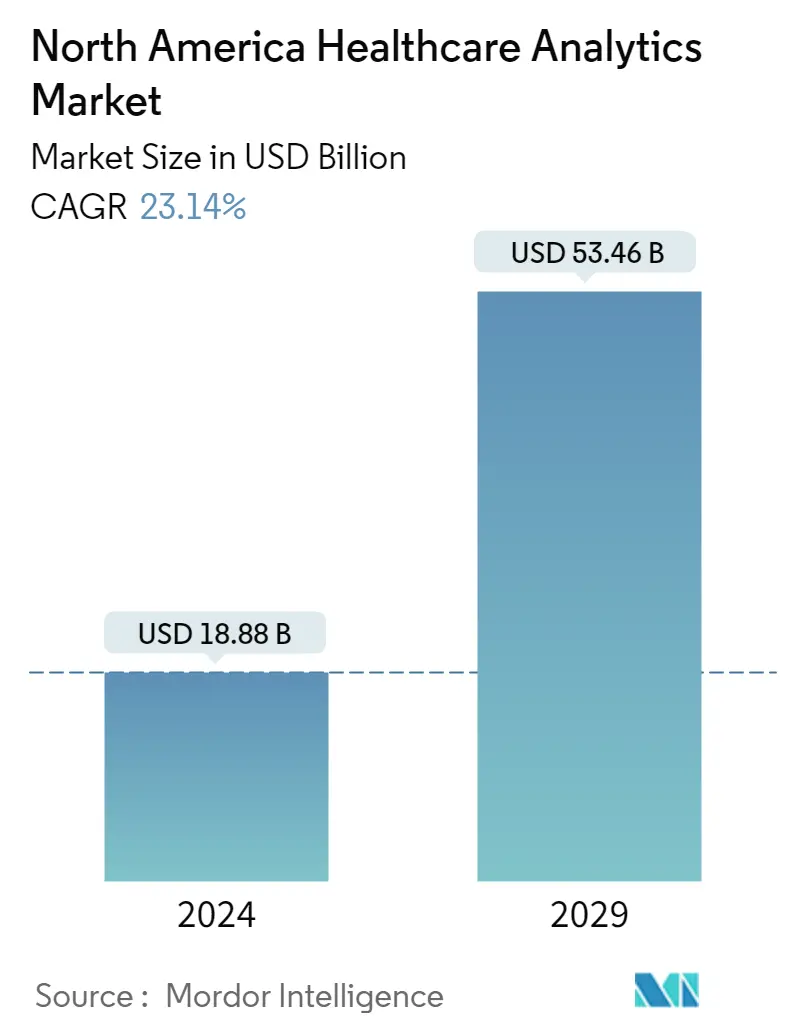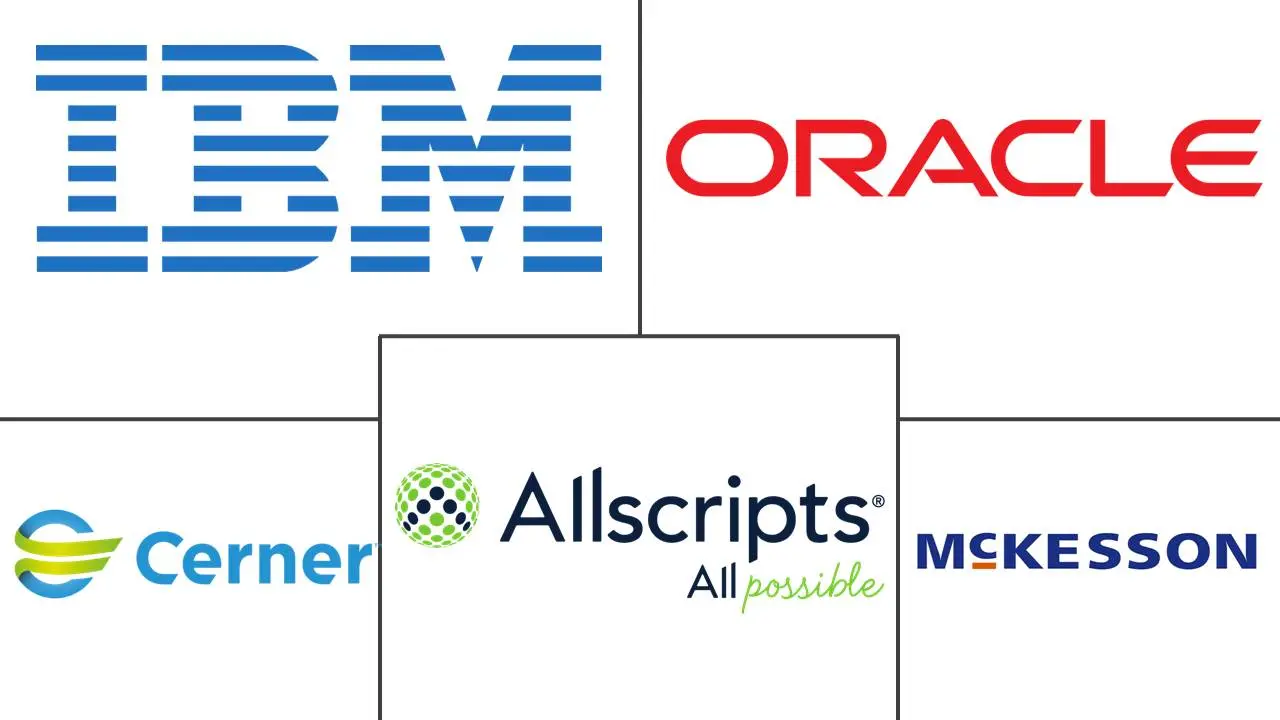Market Size of North America Healthcare Analytics Industry

| Study Period | 2019 - 2029 |
| Base Year For Estimation | 2023 |
| Forecast Data Period | 2024 - 2029 |
| Market Size (2024) | USD 18.88 Billion |
| Market Size (2029) | USD 53.46 Billion |
| CAGR (2024 - 2029) | 23.14 % |
Major Players
*Disclaimer: Major Players sorted in no particular order |
North America Healthcare Analytics Market Analysis
The North America Healthcare Analytics Market size is estimated at USD 18.88 billion in 2024, and is expected to reach USD 53.46 billion by 2029, growing at a CAGR of 23.14% during the forecast period (2024-2029).
The outbreak of the COVID-19 virus has had a predominant effect on the economics and business of major countries of the world. Because of the outbreak, there has been a rise in the significance of big data in the healthcare sector. The prescriptive and predictive analytics solutions have been used to create prediction models to assess the advent of following waves of COVID-19 infection spread in various countries of the world. The rise in the acceptance of electronic health records in developed and developing nations during the pandemic has further fueled the expansion of the market in 2020. For instance, in 2021 an article titled, 'Health Analytics on COVID-19 Data with Few-Shot Learning' reported that health analytics tools can lead to the discovery of useful information and knowledge about diseases such as the coronavirus disease 2019 (COVID-19) and related diseases. This knowledge helps users to get a better understanding of the disease, and thus take part in preventing, controlling, and/or combating the disease.
The factors that drive the North American healthcare analytics market are favorable healthcare policies, the emergence of big data in the healthcare industry, and technological advancements accelerating market growth. The favorable healthcare policies in the region are another region to drive the healthcare analytics market. For instance, in 2022 an article titled 'The Affordable Care Act After a Decade: Its Impact on the Labor Market and the Macro Economy' reported that maturing value-based payment models, more than a decade since the passage of the Affordable Care Act in the United States, continue to create openings for companies that reimagine care delivery with a focus on patient experience, health outcomes, and costs. Also, the pandemic has accelerated the use of digital tools that use big data and machine learning in every health sector, helping to make many operations more efficient and spur innovation. The result could be better health outcomes at a lower cost.
With the recent global pandemic of COVID-19, there need to be strategies to treat this health pandemic. For instance, in 2020 an article titled, 'Big data analytics as a tool for fighting pandemics: a systematic review of the literature' reported that the adoption of big data, as well as big data analytics techniques, have been addressed in this context with the possibility of predicting, mapping, tracking, monitoring, and raising awareness about these epidemics and pandemics. For the collection and analysis of data, the software NVivo 12 and VOSviewer were used. The content analysis sought to identify how big data and big data analytics can help fight epidemics and pandemics. The types and sources of data used in cases of previous epidemics and pandemics were identified, as well as techniques for treating these data. Thus, the use of such technologies is driving the market in the region.
Therefore, due to the above-mentioned factors, the market is expected to show significant growth over the forecast period. However, lack of skilled personnel, data integrity, security issues, and the cost and complexity of software may slow down the growth of the market.
North America Healthcare Analytics Industry Segmentation
As per the scope of the report, healthcare analytics is one of the major service platforms used in the healthcare segment for the marketing of business software and consulting services. It widely uses data, statistical, and qualitative analyses, and explanatory and predictive modeling. The analytics help the healthcare organizations in reducing the hospital stays of patients, regulatory compliance, improving quality healthcare, preclusion of chronic diseases, and fraud detection. The North America healthcare analytics market is segmented by Technology Type (Predictive Analytics, Prescriptive Analytics, and Descriptive Analytics), Application (Clinical Data Analytics, Financial Data Analytics, and Administrative Data Analytics), Component (Hardware, Software, and Services), End-Users (Healthcare Providers, Pharmaceutical and Biotechnology Industries, and Other End Users). The report offers the value (in USD million) for the above segments.
| By Technology Type | |
| Predictive Analytics | |
| Prescriptive Analytics | |
| Descriptive Analytics |
| By Application | |
| Clinical Data Analytics | |
| Financial Data Analytics | |
| Administrative Data Analytics |
| By Component | |
| Hardware | |
| Software | |
| Service |
| By Mode of Delivery | |
| On-premise Model | |
| Cloud- and Web-based Models |
| By End Users | |
| Healthcare Providers | |
| Pharmaceutical and Biotechnology Industries | |
| Other End Users |
| Geography | |
| United States | |
| Canada | |
| Mexico |
North America Healthcare Analytics Market Size Summary
The North American healthcare analytics market is poised for substantial growth, driven by the increasing importance of big data and technological advancements in the healthcare sector. The COVID-19 pandemic has significantly accelerated the adoption of predictive and prescriptive analytics, as these tools have proven essential in modeling and managing the spread of the virus. The integration of electronic health records has further propelled market expansion, as these systems facilitate the efficient collection and analysis of health data. Favorable healthcare policies, such as those stemming from the Affordable Care Act, have also played a crucial role in fostering an environment conducive to innovation and improved patient outcomes. The use of digital tools leveraging big data and machine learning has enhanced operational efficiency across various health sectors, promising better health outcomes at reduced costs.
Despite the promising growth trajectory, the market faces challenges such as a shortage of skilled personnel, data integrity and security concerns, and the complexity and cost of advanced software solutions. However, the potential of predictive analytics in medical decision-making and chronic disease management continues to drive interest and investment in the sector. The ability to anticipate health issues before they escalate, particularly in senior populations, underscores the value of these technologies in preventing unnecessary hospitalizations and reducing healthcare costs. The market is moderately consolidated, with major players like IBM, Oracle, and Cerner Corporation leading the charge, while niche players contribute to a competitive landscape. Recent mergers and acquisitions, such as Oracle's acquisition of Cerner, highlight the ongoing efforts to enhance healthcare delivery through improved data integration and analytics capabilities.
North America Healthcare Analytics Market Size - Table of Contents
-
1. MARKET DYNAMICS
-
1.1 Market Overview
-
1.2 Market Drivers
-
1.2.1 Favorable Healthcare Policies
-
1.2.2 Emergence of Big Data in the Healthcare Industry
-
1.2.3 Technological Advancements Accelerating the Market Growth
-
-
1.3 Market Restraints
-
1.3.1 Lack of Skilled Personnel
-
1.3.2 Data Integrity and Security Issues
-
1.3.3 Cost and Complexity of Software
-
-
1.4 Porter's Five Forces Analysis
-
1.4.1 Threat of New Entrants
-
1.4.2 Bargaining Power of Buyers/Consumers
-
1.4.3 Bargaining Power of Suppliers
-
1.4.4 Threat of Substitute Products
-
1.4.5 Intensity of Competitive Rivalry
-
-
-
2. MARKET SEGMENTATION
-
2.1 By Technology Type
-
2.1.1 Predictive Analytics
-
2.1.2 Prescriptive Analytics
-
2.1.3 Descriptive Analytics
-
-
2.2 By Application
-
2.2.1 Clinical Data Analytics
-
2.2.2 Financial Data Analytics
-
2.2.3 Administrative Data Analytics
-
-
2.3 By Component
-
2.3.1 Hardware
-
2.3.2 Software
-
2.3.3 Service
-
-
2.4 By Mode of Delivery
-
2.4.1 On-premise Model
-
2.4.2 Cloud- and Web-based Models
-
-
2.5 By End Users
-
2.5.1 Healthcare Providers
-
2.5.2 Pharmaceutical and Biotechnology Industries
-
2.5.3 Other End Users
-
-
2.6 Geography
-
2.6.1 United States
-
2.6.2 Canada
-
2.6.3 Mexico
-
-
North America Healthcare Analytics Market Size FAQs
How big is the North America Healthcare Analytics Market?
The North America Healthcare Analytics Market size is expected to reach USD 18.88 billion in 2024 and grow at a CAGR of 23.14% to reach USD 53.46 billion by 2029.
What is the current North America Healthcare Analytics Market size?
In 2024, the North America Healthcare Analytics Market size is expected to reach USD 18.88 billion.

